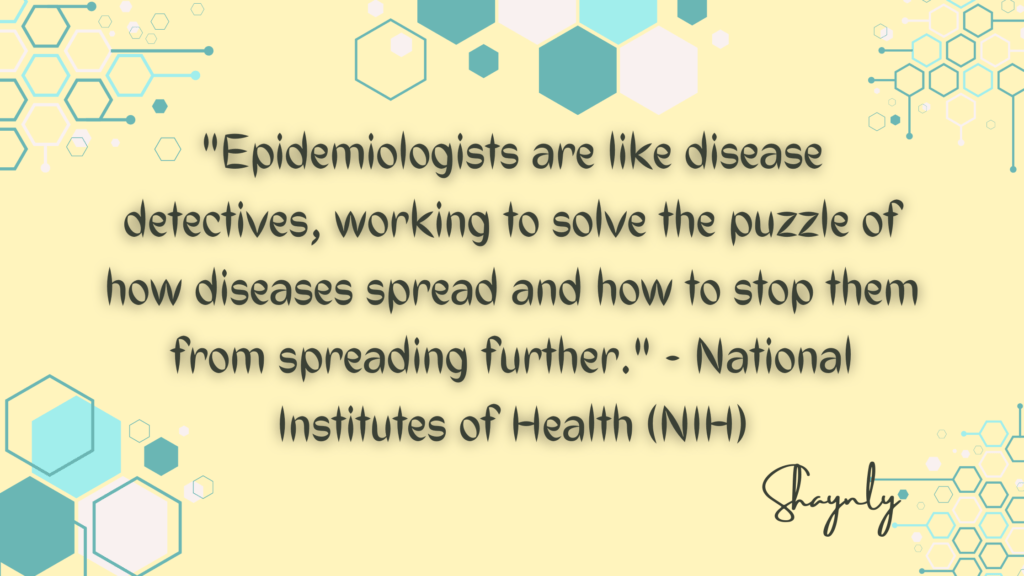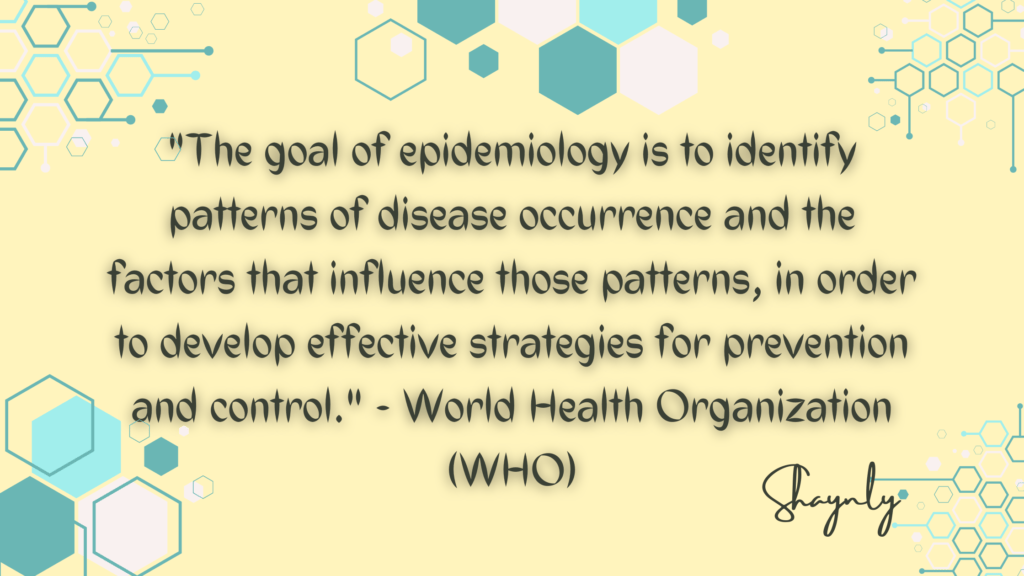Table of Contents
Introduction
As the world faces the challenges of COVID-19, many of us have become familiar with the term epidemiology. But what exactly is it? It is the study of how diseases spread, their causes, and how they can be prevented or treated. In this article, we'll explore the basics of epidemiology and how it plays a vital role in public health.
What is Epidemiology?
It is the study of the distribution and determinants of health and disease in a population. It involves identifying patterns of illness and disease in populations, identifying risk factors, and developing strategies to prevent or control the spread of diseases. Epidemiologists collect and analyze data from a variety of sources, including health surveys, medical records, and laboratory reports.
History of Epidemiology
Epidemiology has its roots in the study of infectious diseases. In the mid-19th century, a cholera outbreak in London led Dr. John Snow to investigate the source of the disease. His research showed that contaminated water from a public well was the source of the outbreak. This discovery led to improvements in sanitation and public health measures, and the birth of modern epidemiology.
Key Concepts in Epidemiology
Incidence and Prevalence
Incidence refers to the number of new cases of a disease in a population over a specific period. Prevalence, on the other hand, refers to the total number of cases of a disease in a population at a given time. These two concepts help epidemiologists understand the burden of disease in a population and how it changes over time.
Risk Factors
Epidemiologists study risk factors, or things that increase the likelihood of a person developing a disease. Risk factors can be biological, such as genetics, or environmental, such as exposure to toxins or lifestyle factors like smoking. Understanding risk factors helps public health officials develop prevention strategies and treatments.
Outbreak Investigation
When a disease suddenly appears in a population, epidemiologists conduct outbreak investigations to identify the source and prevent further spread. These investigations involve collecting data on affected individuals, conducting laboratory testing, and identifying potential sources of infection.

Types of Epidemiology
Descriptive Epidemiology
Descriptive epidemiology involves studying the distribution of disease in a population. It involves collecting data on the number of cases of a disease, where and when they occur, and who is affected. Descriptive epidemiology is used to identify patterns and trends in disease occurrence and to generate hypotheses about the causes of disease.
Analytic Epidemiology
Analytic epidemiology involves testing hypotheses about the causes of disease. It involves comparing the rates of disease in different populations or groups and identifying risk factors for disease. Analytic epidemiology is used to identify the causes of disease and to develop strategies to prevent or control the spread of disease.
Experimental Epidemiology
Experimental epidemiology involves conducting controlled studies to test the effectiveness of interventions to prevent or treat disease. Experimental epidemiology is used to develop new treatments and prevention strategies and to evaluate the effectiveness of existing treatments and prevention strategies.
Clinical Epidemiology
Clinical epidemiology involves studying the causes and outcomes of disease in individual patients. It involves collecting data on patient characteristics, disease progression, and treatment outcomes. Clinical epidemiology is used to develop treatment plans and to evaluate the effectiveness of treatments.
Social Epidemiology
Social epidemiology involves studying the social and economic factors that influence the distribution of disease in a population. It involves examining how factors such as income, education, and occupation affect disease rates. Social epidemiology is used to develop policies and interventions that address social and economic factors that contribute to poor health outcomes.
Principles of Epidemiology
Principle 1: Distribution
The first principle is distribution, which involves studying the patterns of disease occurrence in a population. Epidemiologists examine the frequency, time, and place of disease occurrence to identify patterns and trends in disease occurrence.
Principle 2: Determinants
The second principle is determinants, which involves studying the factors that contribute to disease occurrence. Epidemiologists identify risk factors, such as genetics, environmental factors, and lifestyle factors, that increase the likelihood of disease occurrence.
Principle 3: Populations
The third principle is populations, which involves studying disease occurrence in different populations. Epidemiologists examine how disease rates vary by age, sex, race/ethnicity, and other factors to identify disparities in health outcomes.
Principle 4: Prevention
The fourth principle is prevention, which involves developing strategies to prevent disease occurrence. Epidemiologists develop prevention strategies based on their understanding of the causes and risk factors for disease.
Principle 5: Control
The fifth principle is control, which involves implementing interventions to control the spread of disease. Epidemiologists work with public health officials to implement control measures, such as vaccination programs, quarantine measures, and treatment protocols.

Applications of Epidemiology
Disease Surveillance
Epidemiologists monitor disease trends and outbreaks to identify emerging threats and track the spread of diseases. This information helps public health officials develop prevention strategies and allocate resources to where they are most needed.
Public Health Policy
It provides the scientific evidence needed to develop public health policies and interventions. For example, data on the health effects of smoking has been used to develop tobacco control policies and smoking cessation programs.
Clinical Medicine
It is used to develop treatments for diseases and to improve patient outcomes. Clinical trials, which are studies that test the effectiveness of new treatments, rely on epidemiological data to identify potential study participants and to track outcomes.
Conclusion
It is a vital field that plays a critical role in public health. Its applications are far-reaching, from developing prevention strategies and treatments to tracking the spread of diseases. Understanding the basic concepts of epidemiology can help us make sense of the challenges we face in public health and help us develop effective solutions.
Source
- Centers for Disease Control and Prevention (CDC):
- World Health Organization (WHO)
- National Institutes of Health (NIH)
- American Public Health Association (APHA)
- Journal of Epidemiology and Community Health
FAQ's
How do epidemiologists study disease outbreaks?
Epidemiologists use a variety of methods to study disease outbreaks, including case-control studies, cohort studies, and randomized controlled trials. They also use surveillance systems to monitor the spread of disease and to identify outbreaks early.
What is the difference between incidence and prevalence?
Incidence is the number of new cases of a disease that occur in a given population over a specified period of time, while prevalence is the proportion of a population that has a disease at a given point in time.
What is a risk factor?
A risk factor is any factor that increases an individual's likelihood of developing a particular disease. Risk factors can be genetic, environmental, or behavioral.
What is a confounding factor?
A confounding factor is a factor that is associated with both the exposure and the outcome of interest in a study. Confounding factors can distort the relationship between the exposure and outcome, making it difficult to determine causality.
What is the difference between observational and experimental studies?
Observational studies are studies in which researchers observe individuals without intervening, while experimental studies involve the manipulation of one or more variables. Experimental studies are generally considered to be more rigorous than observational studies.
How has epidemiology impacted public health?
Epidemiology has had a significant impact on public health by identifying risk factors for disease, developing prevention and control strategies, and guiding public health policy. Epidemiological research has led to the development of vaccines, improvements in sanitation and hygiene, and the development of new treatments for disease.
What are some challenges facing epidemiology today?
Some of the challenges facing epidemiology today include emerging infectious diseases, the increasing prevalence of chronic diseases, the globalization of public health threats, and the need for greater collaboration and communication among public health professionals. Additionally, epidemiologists must navigate ethical and political challenges when conducting research and implementing public health interventions.
What is the difference between a pandemic and an epidemic?
A pandemic is an outbreak of a disease that occurs over a wide geographic area and affects an exceptionally high proportion of the population, often crossing international borders. An epidemic, on the other hand, is the occurrence of cases of a disease in a community or region that are clearly in excess of normal expectancy.
What is the role of epidemiology in disease prevention?
Epidemiology plays a critical role in disease prevention by identifying risk factors for disease, developing prevention strategies, and monitoring the spread of disease. Epidemiological research can inform public health policies and interventions that aim to prevent the spread of infectious diseases and reduce the burden of chronic diseases.
How do epidemiologists determine whether an association between an exposure and a disease is causal?
Epidemiologists use a set of criteria known as Bradford Hill's criteria to determine whether an association between an exposure and a disease is causal. These criteria include strength of association, consistency, specificity, temporality, biological gradient, plausibility, coherence, experimental evidence, and analogy.
What is the difference between relative risk and odds ratio?
Relative risk is the ratio of the incidence rate of a disease in an exposed group to the incidence rate of the disease in an unexposed group, while odds ratio is the ratio of the odds of exposure in cases to the odds of exposure in controls. Relative risk is used in cohort studies, while odds ratio is used in case-control studies.
How does epidemiology inform public health policy?
Epidemiological research provides data and evidence that can inform public health policies and interventions. Epidemiologists use their findings to identify risk factors for disease, develop prevention and control strategies, and monitor the spread of disease. This information can be used by public health officials to develop policies that aim to reduce the burden of disease and promote health in communities.

